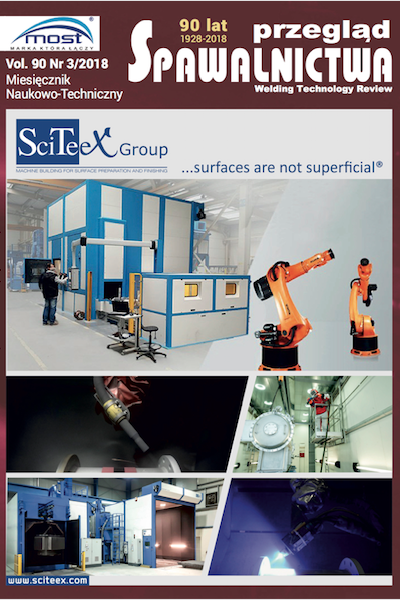Machining surface topography and functional values of parts after EDM and burnishing process
Main Article Content
Abstract
The aim of the reseach was the assesment of the sur- face topography modifications effects shaped by electro- discharge machining and then subjected to dynamic cen- trifugal burnishing by applying the microhammering head. This head is an alternative method of sequential treatment after EDM, to the roto penn head used in the earlier studies. These studies are a continuation of work on the modification of the surface layer by surface cold work treatment of electrodischarge machined components.
Downloads
Article Details
Creative Commons CC BY 4.0 https://creativecommons.org/licenses/by/4.0/
Welding Technology Review (WTR) articles are published open access under a CC BY licence (Creative Commons Attribution 4.0 International licence). The CC BY licence is the most open licence available and considered the industry 'gold standard' for open access; it is also preferred by many funders. This licence allows readers to copy and redistribute the material in any medium or format, and to alter, transform, or build upon the material, including for commercial use, providing the original author is credited.
References
Nowicki B., Podolak-Lejtas A., Dmowska A.: A new method of investigating crater and ash made by individual discharge using scanning prolometers, WEAR 270, 2011, s.121-126, ISSN 0043-1648.
Podolak-Lejtas A., Nowicki B., Dmowska A.: Surface layer propertis after successive EDM or EDA and then super cial roto-peen machining, Advances in Trybology, 2012, pp. 12.
Oczoś K., Liubimov V.: Struktura geometryczna powierzchni, O cyna wydawnicza Politechniki Rzeszowskiej, Rzeszów 2003.
Nowicki B.: Zaawansowane metody opisów i pomiarów struktury geometrycznej powierzchni, Mechanik 1, s. 36-41, 2007.
Grzesik W.: Wpływ obróbki sekwencyjnej na topogra ę powierzchni stali utwardzanej, Mechanik nr 5-6, s. 350-363, 2014.
Grzesik W.: Wpływ topogra i powierzchni na właściwości eksploatacyjne części maszyn, Mechanik nr 8-9, s. 587-593, 2015.
Świercz R., Oniszczuk-Świercz D.: Wpływ parametrów obróbki elektroerozyjnej na właściwości użytkowe stali o wysokiej przewodności cieplnej, Mechanik nr 1, s. 29-34, 2015.
Świercz R., Oniszczuk-Świercz D.: Obróbka elektroerozyjna badanie impulsów elektrycznych napięcia i natężenia prądu, Mechanik nr 2, s. 112- 113, 2017.
Kurth J.P., Van Humbeeck J., Stevens L.: Micro structural investigation and metallographic analysis of the white layer of a surface machined by electro discharge machining, ISEM XI, Losanna, pp. 849-862.
Świercz R., Oniszczuk-Świercz D.: Experimental investigation of surface layer properties of high thermal conductivity tool steel after electrical discharge machining, Metals, vol. 12, 2017, doi:10.3390/met7120550.
Radek N., Żórawski W.: Technologia wytwarzania i właściwości powłok węglikowo-ceramicznych nanoszonych elektroiskrowo- mody kowanych wiązką laserową, Przegląd Spawalnictwa, vol.84(8), s. 11-15, 2012.
Przybylski W.: Technologia obróbki nagniataniem, Wydawnictwo Naukowo-Techniczne, Warszawa 1987.
Radziejewska J., Kalita W.: Badanie wpływu parametrów obróbki hybrydowej na mikrostrukturę warstw wierzchniej, Przegląd Spawalnictwa vol. 81(10), s. 20-26, 2009.
